Thank you, Dr. Price! (or The Joy of Early 20th Century Advertising Cookbooks)
I just finished teaching a course on Advertising and Consumer Culture in the Film Studies Department of a certain university in Eastern Ontario, and one of the online resources that I used in my preparation for the course—and one that I referred my students to—is Duke University’s impressive "Emergence of Advertising in America: 1850-1920" archive. Check it out and you’ll find all kinds of texts and visual materials there documenting the birth of modern consumer culture in the United States—cigarette cards, flyers, posters, outdoor advertising, broadsides, postcards, and “Kodakiana”—you name it—it’s all there. One of the most amazing sections of this website, though, is the section dealing with "advertising cookbooks" from 1879-1929, the Nicole Di Bona Peterson Collection, which contains several dozen examples in full-text format including covers, title pages and illustrations. If you’re a fan of vintage cookbooks and recipes and/or vintage food illustrations, or you’re just interested in how American corporations and other institutions seized upon the cookbook as a vehicle for advertising and early branding, this is the place for you. You’ll find everything from the Best War Time Recipes of 1917, according to the Royal Baking Powder Co. of New York, to Knox Gelatine’s Dainty Desserts for Dainty People, to The Story of Coffee and How to Make It, as brought to you by the good people at Maxwell House, to How Phyllis Grew Thin with the help of the Lydia E. Pinkham Medicine Co. of Lynn, MA.
Among my favorites are:
Dr. Price’s almost hallucinatory selection of “harmlessly” and "exquisitely" colored desserts (see illustration above).
The lovely chocolates produced by our friends at Walter Baker & Co., Ltd. (established 1780!), including the ever-so-tantalizingly named Smith College Fudge, Wellesley Marshmallow Fudge, and Vassar Fudge.
And the Frigidaire Corporation of America’s Frozen Delights, which brings together home refrigeration, modernity, and flapperdom, creating a powerhouse combo.
I’m including a scan of some of Frigidaire’s recipes for your perusal, dear readers. Personally, I’m a little unsure about adding Jell-O to my ice cream (especially lemon Jell-O), but I might just try the Maple Ice Cream or the Strawberry Ice Cream this weekend anyway. (Then again, my maternal Grandmother always used to insist that Jell-O was good for my bones.)
I’ll let you know how it turns out if I do.
aj
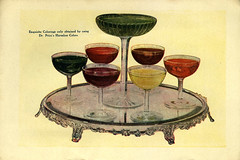
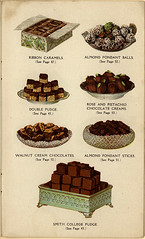
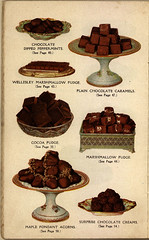
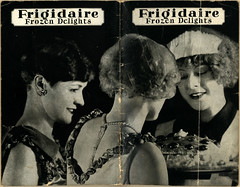
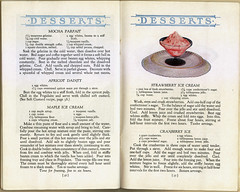









3 comments:
I remember those "Jell-O" recipes very much, they were quite the hit in the 60's --- I had an excellent recipe for a 'Lemon Jell-O' cheese cake!
Apparently they were a huge hit in the 1920s--you can find a few "Jell-O: America's Most Famous Dessert" cookbooks in the Peterson Collection.
Gelatine-based desserts had been around for a while, of course, but companies like Jell-O and Knox made these desserts simple, everyday affairs.
They became less stuffy and more modern.
But, yeah, cookbooks and food magazines of the '50s and '60s always have tons of those day-glo Jell-O desserts. Mmm.
I love the Jell-O recipe booklets. They've been published almost continually for over 100 years. I like that each individual booklet represents a small snapshot of a particular point in time, while collectively, they represent a century's worth of successful product branding. Such an amazingly complete portrait, all based on a simple box of colored sugar.
Post a Comment